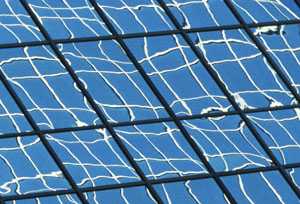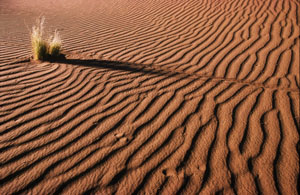 Repeated patterns can make strong, if somewhat abstract images. Such images may be considered controversial in some of the more conservative photographic arenas simply because they are seen as having no subject or centre of interest. There is a degree of validity in this sort of comment, but carefully chosen repeating patterns skillfully arranged in the frame can nevertheless make very satisfying images. The eye follows repeated shapes, lines or colours from one area to another and ultimately explores the whole image. Compositions of this type rely to a great extent on simplicity, and may feature monochromatic colour, simple but strong diagonal lines, or repeated elements with perhaps the smallest of variations strategically placed.
Repeated patterns can make strong, if somewhat abstract images. Such images may be considered controversial in some of the more conservative photographic arenas simply because they are seen as having no subject or centre of interest. There is a degree of validity in this sort of comment, but carefully chosen repeating patterns skillfully arranged in the frame can nevertheless make very satisfying images. The eye follows repeated shapes, lines or colours from one area to another and ultimately explores the whole image. Compositions of this type rely to a great extent on simplicity, and may feature monochromatic colour, simple but strong diagonal lines, or repeated elements with perhaps the smallest of variations strategically placed.
Patterns of this type can be found everywhere, and sometimes in the most unexpected places. Natural subjects and architecture both offer fertile starting points. In the natural world, try looking at objects or plants more closely than normal. Leaves and flowers feature exquisitely beautiful patterns when examined close up. Take a walk in the countryside a have a look at the fresh bracken as it breaks out in spring. There are wonderful patterns to be found and also beautiful shades of green just waiting to be photographed. In even modest architecture there are patterns in roof tiles and walls, and never overlook the widows of modern glass office blocks. Small man-made objects can also make rewarding subjects. Try a length of rope, or a box containing a large number of identical items arranged in neat rows. With good light and a little creativity, excellent images can be obtained.
Repeating patterns are perhaps most interesting when they occupy a significant portion of an image and extend to at least two or three of the edges of the frame. For the most effective images a predictable rhythm needs to be established in the viewers mind. Two or three repeats of a pattern are barely sufficient to achieve this, although the effect depends to a large extent upon the subject. Odd numbers of repeats may also be more dynamic that even numbers, although the difference loses significance as the number of repeats increases. Pure patterns, those featuring numerous precise repeats in an absolutely predictable manner, can be very satisfactory given good light, colour and graphic design. However, patterns can also be disturbed, or broken at a strategic location in an image, by small objects which catch they perhaps because they are of a contrasting colour.
As objects are examined more closely, this type of work moves into the area of macro photography. Repeated elements get smaller and smaller, and may ultimately become more akin to texture. At this point the subject becomes somewhat different because patterns are usually random. Nevertheless natural patterns in pebbles, wood grain and so on can also be used to portray rhythm.






